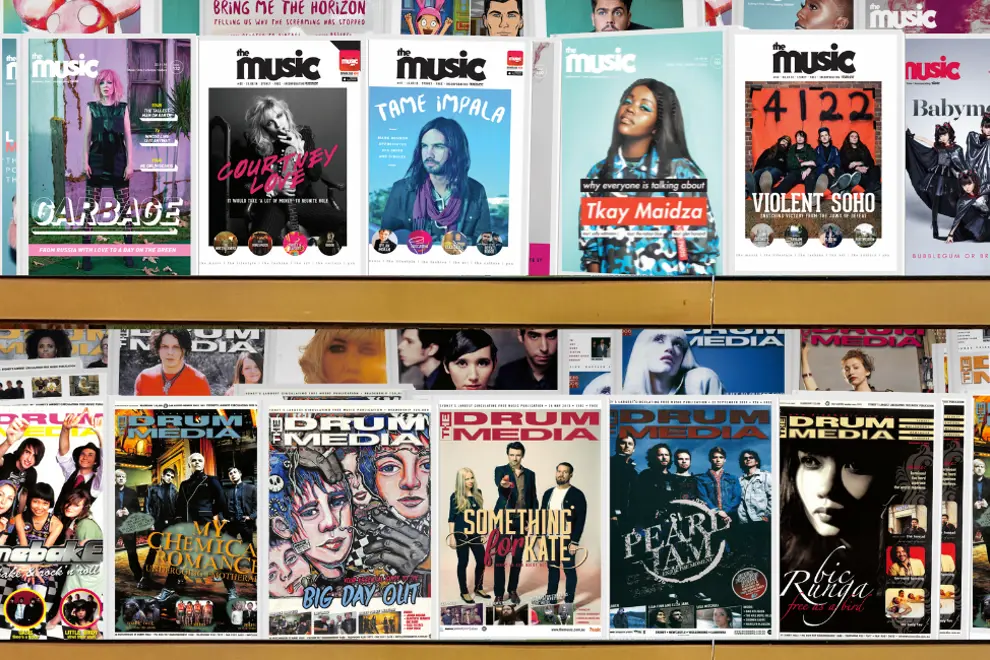In the before times, social media was on the street rather than on the screen. The Music’s predecessor was literally called On The Street, a music and arts newspaper distributed for free around the city and into the suburbs via record stores and cafes. Known as ‘street press’, few papers like this formed the backbone of the industry – free to access, breeding grounds for all types of creatives, and beloved by audiences.
Part of the hidden history of street press is the hidden legacy of women in the music business. Unlike newspapers and ‘rock mags’ like Go-Set or Juke, in Sydney, the scene was set by the women of the street press. One of the best, and first, was Margaret Cott. With Elinor Boyd, Katherine Armytage, and later, her sister Jennifer Cott and a host of others, she led a local media revolution that was inclusive, accessible and affordable for bands and audiences of all sizes and experience.
On The Street started as liftout to Sydney newspaper City Express, dreamed up by music industry types to let people know what was going on with their artists and gigs. From a small pamphlet (advertising, mostly) to a full-blown newspaper with reviews, features, images and independent commentary, it soon became essential reading.
Those in the know couldn’t wait to be featured, while those wanting to know knew where to go to find out. The diversity was staggering, with all genres, eras, and ages represented, it seemed. Importantly, it wasn’t just headliners and established artists but listings for brand new groups, venues with their first stage set up in the corner, and audiences from across NSW and the inner city, all looking to see where the wind might take them.
“When I first started about 82, late 82/83, my very first job was to go up with Elinor [to the Frontier Offices],” remembers Cott. “She would dress all in black, and I’d have my little red shoes on … And Elinor would be talking about The Flaming Hands and Renée Geyer like they were her best friends, and I’d be madly writing things down, writing when the next gig was. And then we’d get all the listings, and that was it: all these little box ads [ads on rows about a business card] on this piece of paper.”
It wasn’t long before On The Street outplayed the City Express in all areas, and it soon moved from an insert to stand out on its own. Keeping a music newspaper afloat wasn’t easy, though, and when Cott took over, it was hardly a good business proposition.
Cott explained that when she was handed the reigns, the former owner simply said, “Look, Marg, just make sure when you leave you turn the lights out”, leaving her with a paper that was 20 thousand dollars in the red, but with a keen community behind it. Along with some excellent young folk and experienced industry types (including bookkeeper Ellie, who Cott remembers as “in her late 60s… and fantastic, she really watched everything, you couldn’t ask for a pen if you already had one, she was a tough nut!”), they built the street press industry.
“It was slightly better than a fanzine and a pretty basic newspaper. But because everybody was involved at such an early stage, all the rehearsal studios and just that groundbase swell, it literally started from the engine room, you know. There were so many gigs and so many bands and so many opportunities to play live. There [were] so many recording studios too, places where the high-end guys like INXS or someone would be recording, then there were 20 little recording studios – so there was this vast amount of material that came out of that period of time,” Cott explained.
“With the live scene being so effective and getting a ground swell happening, it meant people were actively going out and buying records, going out and picking up copies of On The Street, of whatever was up for sale, the CD, the LP, the single, whatever it was that was being promoted.” Looking back, it’s easy to assume everyone knew what they were doing and had planned for it, but Cott sees it differently.
Although she’d come from a publishing and advertising background and was clearly great at working in teams and building teams, she insisted everyone was developing as they went. “It wasn’t just us learning on our feet; the whole industry was learning, really, and everyone was getting better at what they did (laughs), which was good.”
In 1990, a mass walkout, prompted by a threat to fire another beloved bookkeeper, meant a divide from On The Street and the formation of Drum Media. “I packed up my handbag, and I walked out, and by the time I got down to the bottom of stairs [almost everyone else had followed],” says Cott. Having not thought about her own future, let alone that of a whole staff, they decided to go straight to the local for some beers, and over a few, they cooked up a plan. Ten days later, Drum Media was published, with the first issue featuring Midnight Oil.
“We were coming out of coming out of the Supreme Court, in Sydney [having just been formally given permission to print]”, laughs Cott, “I was in a taxi, and there was my sister Jenny and I and my Father. And there was a copy of that first issue under someone's arm … it was it was like a sign from heaven, or hell, what a hoot!”
From there, the rest is history. Drum Media was under Cott’s care until 2006, where she and Jenny left it in rude health. Like On The Street, it was the launching pad for literally thousands of Australian creatives, from musicians to writers, photographers to designers, and those of us with weird and wacky in-between jobs now like academics, speech writers, communications officers and the rest.
Always a place where diversity and inclusion were possible; it wasn’t just about if something would sell or if someone had a profile, but more importantly if they were having a good go.
To celebrate the launch of The Music’s street press archive, this week will see us expand further on its history and legacy in Australia with deep dives into Inpress and 3D World by renowned journalists Jeff Jenkins and Cyclone Wehner, respectively.
If you want to visit the archive, visit TheMusic.com.au, find “Street Press Archive” in the main menu and register to start your journey through Australian music history. Happy reading!
Can you help us fill the gaps in our collection? Click here for details on how to add to our archive.






